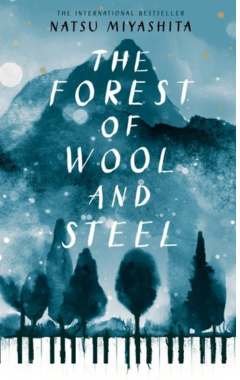The Forest of Wool and Steel

This beautiful and gentle novel chronicles the life of a young Japanese man, Tomura, who discovers the joy of sound and music through his training and work as a Piano Tuner. It is a story for the senses, bringing the reader on a sensory experience through the world of musical sound. It also explores the theme of finding one’s vocation in life and pursing that passion through the various challenges and obstacles along the way.
We are first introduced to Tomura as a seventeen-year-old in high school, where one day, he is asked to direct a Piano Tuner to the piano in the school gymnasium. He has no concept whatsoever as to the role of a Piano Tuner. However, within moments of hearing the piano being tuned, he is stopped in his tracks when hearing the most flawless and mellow of rhythmic sounds echoing from the gym. Up to this point, Tomura is very unsure as to where his future is leading him, but this pivotal moment changes the trajectory of his life and brings him on a life journey where his insatiable love of acoustics and music begin.
The story, is told in a way that illustrates the life lessons Tomura gains from his work, his constant desire to learn and have a better understanding of the creation of sound and music, his setbacks and the advice he receives from colleagues (his mentors). In a way, it’s a heartfelt coming-of-age tale where we observe his change from a young man struggling with self-doubt and trying to find his place and purpose in the world to his metamorphosis in the dedication, patience and imagination required for a career in piano tuning.
Throughout the book, the musical sound from a piano conjures images of forests and smells and certain moods and tone. There are many poetic analogies made between ‘the scenery of sound’ from the piano and the sounds emanating from aspects of nature, forests in particular. The descriptions of the acoustics of music are blended with that of the natural world. The metaphors also go to explain the title of the book, The Forest of Wool and Steel. Tomura’s home place is next-door to a sheep farm in the mountains, hence there are many interlinked references and analogies made in relation to the construct of a piano – pianos primarily use spruce wood as their soundboards, piano hammers are made from the felt of sheep’s wool, and steel strings are attached to eighty-eight piano keys, each with one to three strings attached.
Tomura is a very likeable, philosophical character, at times overly earnest and naive, with a great sense of humility but also remaining quietly determined. He views himself as ‘a mere apprentice’, who is very keen to learn while simultaneously recognising that the world of piano tuning is a trade that requires lifelong commitment and a strong imagination. He worries he cannot accomplish the finer aspects of tuning and on many an occasion, lacks the easy confidence and conviction in his tuning skills. He is keenly aware of his limitations and is also of the belief that serendipity had a part to play in him becoming a Piano Tuner.
Though the novel centres on one young man’s passion for musical notes and sounds, this story will appeal to anyone who has an appreciation of the creative arts. There are some gorgeous, detailed imagery of the intricacies involved in creating an organic sound from a piano. The book also makes many links and connections between musical sounds produced from a piano to that of the many sensory experiences of the natural world. We see when in producing musical sound, Tomura’s sense of curiosity and sensitivity to all things auditory, instils in him feelings of nostalgia and longing, whether that of the scent of a forest, the sound of whispering leaves, or the feeling of damp air at dusk.
The descriptions of nature and landscape intertwine with a narrative about music, making the novel quite a charming and contemplative read. The Forest of Wool and Steel concludes with the meditative question as to what the Piano Tuner is ultimately trying to achieve, i.e. finding and extracting the good and beautiful, that which already exists within the piano. Tomura, however, has that one sussed out, “If a piano can bring to life the beauty that has become invisible to us, and give it audible form, then it is a miraculous instrument and I thrill to be its lowly servant”.











